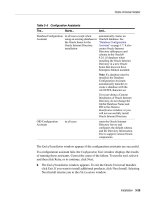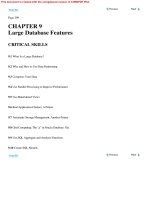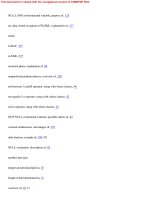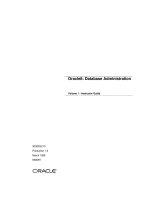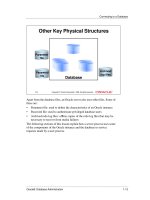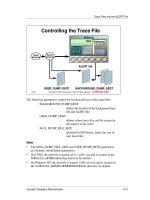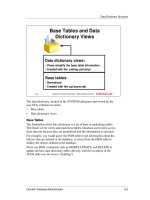oracle 8 database administration volume 1 instruction guide phần 6 pps
Bạn đang xem bản rút gọn của tài liệu. Xem và tải ngay bản đầy đủ của tài liệu tại đây (463.95 KB, 40 trang )
Oracle8: Database Administration 7-7
.
LGWR, Log Switches, and Checkpoints
LGWR, Log Switches, and Checkpoints
Redo Log Buffer and the Background Process LGWR
The Oracle Server sequentially records all changes made to the database in
the redo log buffer. The redo log buffer is used in a circular manner. The
redo entries are written to one of the online redo log groups called the
current online redo log group by the LGWR process under the following
situations:
• When a commit occurs
• When the redo log buffer pool becomes one-third full
• When an LGWR timeout occurs (every three seconds)
• Before the DBWR writes modified blocks in the database buffers cache
to the data files
Log Switches
LGWR writes to the online redo log files sequentially—that is, when the
current online redo log group is filled, LGWR begins writing to the next
group. When the last available online redo log file is filled, LGWR returns to
the first online redo log group and starts writing again.
7-5
Copyright Oracle Corporation, 1998. All rights reserved.
Oracle Architecture
Database
Instance
SGA
CKPT LGWR DBWR
Database
buffer
cache
Control
files
Data files
Redo log
files
Redo log
buffer
ARCH
Archived
log files
Parameter
file
Password
file
7-8 Oracle8: Database Administration
.
Lesson 7: Maintaining Redo Log Files
A log switch is the event during which LGWR stops writing to one online
redo log group and starts writing to another.
The database administrator can also force log switches (see subsequent
sections). Each time a log switch occurs and LGWR begins writing to a new
log group, the Oracle server assigns a number known as the log sequence
number to identify the set of redo entries.
When a log switch occurs, an event called a checkpoint is initiated.
Checkpoints
During a checkpoint:
• All dirty database buffers covered by the log being checkpointed are
written to the data files by DBWR.
• The checkpoint background process CKPT updates the headers of all
data files and control files to reflect that it has successfully completed.
Checkpoints can occur for all data files in the database or for only specific
data files.
A checkpoint occurs, for example, in the following situations:
• At every log switch
• When an instance has been shut down with the normal, transactional, or
immediate option
• When forced by setting the initialization parameters,
LOG_CHECKPOINT_INTERVAL and
LOG_CHECKPOINT_TIMEOUT (see subsequent sections)
• When manually requested by the database administrator (see subsequent
sections)
Information about each checkpoint is recorded in the ALERT file if the
initialization parameter LOG_CHECKPOINTS_TO_ALERT is set to
TRUE. The default value of FALSE for this parameter does not log
checkpoints.
Instructor Note
Mention that there are additional situations in which checkpoints occur; for
example when taking a tablespace offline or making it read only.
Oracle8: Database Administration 7-9
.
Archiving Redo Log Files
Archiving Redo Log Files
7-6
Copyright Oracle Corporation, 1998. All rights reserved.
Without Archiving
Backup
Disk failure
100
101
t1 t2
Data files
Control
files
50 51
7-7
Copyright Oracle Corporation, 1998. All rights reserved.
50
With Archiving
Backup
Disk failure
Data files
Control
files
50 51
100
101
Archived
redo logs
t1 t2
99
7-10 Oracle8: Database Administration
.
Lesson 7: Maintaining Redo Log Files
Archiving Redo Log Files
One of the important decisions that a database administrator has to make is
whether the database is configured to operate in ARCHIVELOG or in
NOARCHIVELOG mode.
NOARCHIVELOG Mode
In NOARCHIVELOG mode, the online redo log files are overwritten each
time an online redo log file is filled, and log switches occur. LGWR will not
overwrite a redo log group until the checkpoint for that group is completed.
ARCHIVELOG Mode
If the database is configured to run in ARCHIVELOG mode, inactive groups
of filled online redo log files must be archived. Since all changes made to the
database are recorded in the online redo log files, the database administrator
can use the physical backup and the archived online redo log files to recover
the database without losing any committed data due to any kind of failure.
There are two ways in which online redo log files can be archived:
• Manually
• Automatically
The initialization parameter LOG_ARCHIVE_START indicates whether
archiving should be automatic or manual when the instance starts up.
• TRUE indicates that archiving is automatic. ARCH will initiate
archiving of the filled log group at every log switch.
• FALSE, the default value, indicates that the database administrator will
archive filled redo log files manually. A Server Manager command must
be executed each time you want to archive an online redo log file. All or
specific online redo log files can be archived manually.
Note
This is covered in more detail in the course Oracle8: Backup and Recovery
Workshop.
Instructor Note
Point out that ARCHIVELOG mode is a database setting, whereas
automatic archiving is a characteristic of the instance.
Oracle8: Database Administration 7-11
.
Obtaining Log and Archive Information
Obtaining Log and Archive Information
The following Server Manager command shows the database log mode and
if the automatic archival is enabled.
SVRMGR> ARCHIVE LOG LIST
Database log mode No Archive Mode
Automatic archival Disabled
Archive destination ?/dbs/arch
Oldest online log sequence 688
Current log sequence 689
7-8
Copyright Oracle Corporation, 1998. All rights reserved.
• Server Manager command:
• V$DATABASE:
– NAME
– LOG_MODE
• V$INSTANCE
– ARCHIVER
Obtaining Information
About Archiving
ARCHIVE LOG LIST;
7-12 Oracle8: Database Administration
.
Lesson 7: Maintaining Redo Log Files
Query the dynamic performance views V$DATABASE and V$INSTANCE
to show the database log mode and the archiving mode.
SVRMGR> SELECT name, log_mode
2> FROM v$database;
NAME LOG_MODE
U15 NOARCHIVELOG
1 row selected.
SVRMGR> SELECT archiver
2> FROM v$instance;
ARCHIVE
STOPPED
1 row selected.
Oracle8: Database Administration 7-13
.
Obtaining Log and Archive Information
To see the number of online redo log groups, the current log group, and the
sequence number, query the dynamic performance view V$THREAD. This
is of particular interest for Parallel Server administrators.
SVRMGR>SELECT groups, current_group#,sequence#
2>FROM v$thread;
GROUPS CURRENT_GR SEQUENCE#
2 1 689
1 row selected.
7-9
Copyright Oracle Corporation, 1998. All rights reserved.
Obtaining Information
About Groups
V$THREAD:
• GROUPS
• CURRENT_GROUP#
• SEQUENCE#
7-14 Oracle8: Database Administration
.
Lesson 7: Maintaining Redo Log Files
The following query returns information about the online redo log file from
the control file:
SVRMGR>SELECT group#,sequence#,bytes,members,status
2>FROM v$log;
GROUP# SEQUENCE# BYTES MEMBERS STATUS
1 688 1048576 1 CURRENT
2 689 1048576 1 INACTIVE
2 rows selected.
The following items are the most common values for the STATUS column:
• UNUSED indicates that the online redo log group has never been
written. This is the state of an online redo log file that was just added.
• CURRENT indicates the current online redo log group. This implies that
the online redo log group is active.
7-10
Copyright Oracle Corporation, 1998. All rights reserved.
Obtaining Information About
Groups and Members
V$LOG:
• GROUP#
• MEMBERS
• STATUS
• SEQUENCE#
•BYTES
Oracle8: Database Administration 7-15
.
Obtaining Log and Archive Information
• ACTIVE indicates that the online redo log group is active but is not the
current online redo log group. It is needed for crash recovery. It may or
may not be archived.
• INACTIVE indicates that the online redo log group is no longer needed
for instance recovery. It may or may not be archived.
7-16 Oracle8: Database Administration
.
Lesson 7: Maintaining Redo Log Files
To obtain the names of all the members of a group, query the dynamic
performance view V$LOGFILE in which the value of the STATUS column
could be:
• INVALID indicates that the file is inaccessible
• STALE indicates that contents of the file are incomplete; for example,
adding a log file member
• DELETED indicates that the file is no longer used
• NULL indicates that the file is in use
SVRMGR>SELECT *
2>FROM v$logfile;
GROUP# STATUS MEMBER
1 /DISK3/log1a.rdo
2 /DISK4/log2a.rdo
7-11
Copyright Oracle Corporation, 1998. All rights reserved.
Obtaining Information About
Groups and Members
V$LOGFILE:
• GROUP#
• STATUS
•MEMBER
Oracle8: Database Administration 7-17
.
Controlling Log Switches and Checkpoints
Controlling Log Switches and Checkpoints
Log switches and the checkpoints are events that happen automatically, for
example, when the current online log file group is filled. But log switches
can be forced.
Forcing Log Switches
You can force a log switch using the following SQL command:
SVRMGR>ALTER SYSTEM SWITCH LOGFILE;
OEM
1 Use Backup Manager.
2 Choose Subsystem.
3 Select Logfile—>Switch Logfile.
7-12
Copyright Oracle Corporation, 1998. All rights reserved.
• Force log switches with the command:
• Control checkpoints with the
initialization parameters:
– LOG_CHECKPOINT_INTERVAL
– LOG_CHECKPOINT_TIMEOUT
Log Switches and Checkpoints
ALTER SYSTEM SWITCH LOGFILE;
7-18 Oracle8: Database Administration
.
Lesson 7: Maintaining Redo Log Files
Forcing Checkpoints
The database administrator can manually force a checkpoint by using:
ALTER SYSTEM CHECKPOINT;
OEM
1 Use Oracle Backup Manager.
2 Choose Subsystem.
3 Select Logfile—>Force Checkpoint.
Setting Database Checkpoint Intervals
When the database uses large online redo log files you can set additional
database checkpoints by setting the initialization parameters:
• LOG_CHECKPOINT_INTERVAL
• LOG_CHECKPOINT_TIMEOUT
LOG_CHECKPOINT_INTERVAL
A checkpoint is initiated as soon as the LGWR writes the number of blocks
specified by the parameter LOG_CHECKPOINT_INTERVAL.
The value of LOG_CHECKPOINT_INTERVAL is specified in operating
system blocks and not Oracle database blocks.
Regardless of this value, a checkpoint always occurs when switching from
one online redo log file to another.
If the value exceeds the actual online redo log file size, checkpoints occur
only when switching logs.
Note that specifying a value of 0 for the interval might cause checkpoints to
be initiated very frequently since a new request will be started even if a
single redo log buffer has been written since the last request was initiated.
LOG_CHECKPOINT_TIMEOUT
The value of this initialization parameter specifies the maximum amount of
time before another checkpoint occurs. The value is specified in seconds.
The time begins at the start of the previous checkpoint, and then a
checkpoint occurs after the amount of time specified by this parameter.
Specifying a value of 0 for the timeout disables time-based checkpoints.
Oracle8: Database Administration 7-19
.
Multiplexing and Maintaining Members and Groups
Multiplexing and Maintaining Members and Groups
In some cases you might need to create additional log file groups. For
example, adding groups can solve availability problems. To create a new
group of online redo log files, use the following SQL command:
ALTER DATABASE [database]
ADD LOGFILE [GROUP integer] filespec
[, [GROUP integer] filespec] ]
You specifiy the name and location of the members with the file
specification. The value of the GROUP parameter can be chosen for each
redo log file group. If you omit this parameter, the Oracle server generates
its value automatically.
OEM
1 Use Backup Manager.
2 Choose Subsystem.
3 Select Logfile—>Add Logfile Group.
7-13
Copyright Oracle Corporation, 1998. All rights reserved.
log3a.rdo
Adding Online Redo Log Groups
Group 1 Group 2 Group 3
ALTER DATABASE ADD LOGFILE
(‘/DISK3/log3a.rdo’,
‘/DISK4/log3b.rdo’) size 1M;
log3b.rdo
log1a.rdo
log1b.rdo
log2b.rdo
7-20 Oracle8: Database Administration
.
Lesson 7: Maintaining Redo Log Files
You can add new members to existing redo log file groups using the
following ALTER DATABASE ADD LOGFILE MEMBER command:
ALTER DATABASE [database]
ADD LOGFILE MEMBER
[ 'filename' [REUSE]
[, 'filename' [REUSE]]
TO {GROUP integer
|('filename'[, 'filename'] )
}
]
Use the fully-specified name of the log file members, otherwise the files will
be created in a default directory of the database server.
7-14
Copyright Oracle Corporation, 1998. All rights reserved.
Adding Online Redo
Log Members
Group 2Group 1
ALTER DATABASE ADD LOGFILE MEMBER
‘/DISK4/log1b.rdo’ TO GROUP 1,
‘/DISK4/log2b.rdo’ TO GROUP 2;
log2b.rdo
log2a.rdo
log1b.rdo
log1a.rdo
Oracle8: Database Administration 7-21
.
Multiplexing and Maintaining Members and Groups
If the file already exists, it must have the same size and you must specify the
REUSE option. You can identify the target group either by specifying one or
more members of the group or by specifying the group number.
OEM
1 Use Backup Manager.
2 Choose Subsystem.
3 Select Logfile—>Add Logfile Member.
7-22 Oracle8: Database Administration
.
Lesson 7: Maintaining Redo Log Files
Relocating Online Redo Log Files
The locations of the online redo log files can be changed by renaming the
online redo log files. Before renaming the online redo log files, ensure that
the new online redo log file exists. The Oracle server changes only the
pointers in the control files, but does not physically rename or create any
operating system files.
The following ALTER DATABASE RENAME FILE command changes the
name of the online redo log file:
ALTER DATABASE [database]
RENAME FILE 'filename'[, 'filename']
TO 'filename'[, 'filename']
OEM
1 Use Backup Manager.
2 Choose Subsystem.
3 Expand the Logfile Group node.
4 Select the log file group.
5 Change the filename in the property sheet.
7-15
Copyright Oracle Corporation, 1998. All rights reserved.
How to Relocate
Online Redo Log Files
1. Shut down the database.
2. Copy the online redo log files to the
new location.
3. Mount the database.
4. Execute the ALTER DATABASE
RENAME FILE command.
5. Open the database.
Oracle8: Database Administration 7-23
.
Dropping Online Redo Log Groups and Members
Dropping Online Redo Log Groups and Members
To increase or decrease the size of online redo log groups, add new online
redo log groups (with the new size) and then drop the old one.
An entire online redo log group can be dropped with the following ALTER
DATABASE DROP LOGFILE command:
ALTER DATABASE [database]
DROP LOGFILE
{GROUP integer|('filename'[, 'filename'] )}
[,{GROUP integer|('filename'[, 'filename'] )}]
OEM
1 Use Backup Manager.
2 Choose Subsystem.
3 Expand the Logfile Group node.
4 Select the log file group.
5 Select Logfile—>Drop Logfile Group.
6 Click OK.
7-16
Copyright Oracle Corporation, 1998. All rights reserved.
Dropping Online Redo
Log Groups
Group 1 Group 2
Group 3
ALTER DATABASE DROP LOGFILE
GROUP 3;
log1a.rdo
log2a.rdo
log3b.rdo
log3a.rdo
log1b.rdo
log2b.rdo
7-24 Oracle8: Database Administration
.
Lesson 7: Maintaining Redo Log Files
Restrictions
• An instance requires at least two groups of online redo log files.
• An active group cannot be dropped.
• If the database is running in ARCHIVELOG mode and the log file group
is not archived, then the group cannot be dropped.
• When an online redo log group is dropped, the operating system files are
not deleted.
Oracle8: Database Administration 7-25
.
Dropping Online Redo Log Groups and Members
You may want to drop an online redo log member, because it is INVALID.
Use the following ALTER DATABASE DROP LOGFILE MEMBER
command, if you want to drop one or more specific online redo log
members:
ALTER DATABASE [database]
DROP LOGFILE MEMBER 'filename'[, 'filename']
OEM
1 Use Backup Manager.
2 Choose Subsystem.
3 Expand the Logfile Member node.
4 Select the log file member.
5 Select Logfile—>Drop Logfile Member.
6 Click OK.
7-17
Copyright Oracle Corporation, 1998. All rights reserved.
Dropping Online Redo
Log Members
Group 2Group 1
ALTER DATABASE DROP LOGFILE MEMBER
‘/DISK4/log2b.dbf’;
log1a.rdo
log2b.rdo
log1b.rdo
log2a.rdo
7-26 Oracle8: Database Administration
.
Lesson 7: Maintaining Redo Log Files
Restrictions
• If the member you want to drop is the last valid member of the group,
you cannot drop that member.
• If the group is active, you must force a log file switch before you can
drop the member.
• If the database is running in ARCHIVELOG mode and the log file group
to which the member belongs is not archived, then the member cannot be
dropped.
• When an online redo log member is dropped, the operating system file is
not deleted.
Oracle8: Database Administration 7-27
.
Clearing Online Redo Log Files
Clearing Online Redo Log Files
If a redo log file is corrupted in all members, the database administrator can
solve this problem by reinitializing these log files.
The SQL command ALTER DATABASE CLEAR LOGFILE reinitializes
online redo log files:
ALTER DATABASE [database]
CLEAR [UNARCHIVED] LOGFILE
{GROUP integer|('filename'[, 'filename'] )}
[,{GROUP integer|('filename'[, 'filename'] )}]
Using this command is equivalent to adding and dropping an online redo log
file. But you can issue this command even if there are only two log groups
with one file each and even if the cleared group is available but not archived.
Restrictions
You can clear an online redo log file whether it is archived or not. However,
when it is not archived, you must include the keyword UNARCHIVED. This
will make backups unusable if the online redo log file is needed for recovery.
Note
This is covered in more detail in the course Oracle8: Backup and Recovery
Workshop.
7-18
Copyright Oracle Corporation, 1998. All rights reserved.
Clearing Online Redo Log Files
ALTER DATABASE CLEAR LOGFILE
‘/DISK3/log2a.rdo’;
Example
7-28 Oracle8: Database Administration
.
Lesson 7: Maintaining Redo Log Files
Planning Online Redo Logs
Number of Online Redo Log Files
To determine the appropriate number of online redo log files for a database
instance you have to test different configurations.
In some cases, a database instance may require only two groups. In other
situations, a database instance may require additional groups to guarantee
that the groups are always available to LGWR. For example, if messages in
the LGWR trace file or in the ALERT file indicate that LGWR frequently
has to wait for a group because a checkpoint has not completed, or a group
has not been archived, you need to add groups.
Although the Oracle server allows multiplexed groups to contain different
numbers of members, try to build up a symmetric configuration. An
asymmetric configuration should only be the temporary result of an unusual
situation such as a disk failure.
Instructor Note
Ask the students to identify problems with the configuration shown in the
slide.
7-19
Copyright Oracle Corporation, 1998. All rights reserved.
Online Redo Log Configuration
Group 1 Group 2
Group 3
Member
Member
Disk 3Disk 2Disk 1
Member
Member
Member
Oracle8: Database Administration 7-29
.
Planning Online Redo Logs
Location of Online Redo Log Files
When you multiplex the online redo log files, place members of a group on
different disks. By doing this, even if one member is not available, but other
members are available, the instance does not shut down.
Separate archive log files and online redo log files on different disks, to
reduce contention between the ARCH and LGWR background process.
Data files and online redo log files should be placed on different disks to
reduce LGWR and DBWR contention and reduce the risk of losing both
data files and online redo log files in the event of media failure.
Sizing Online Redo Log Files
The minimum size of an online redo log file is 50 K and the maximum size
is operating system specific. Members of different groups can have different
sizes; however, there is no benefit to having different sized groups.
Different sized groups should only be required as a temporary result if you
want to change the size of the members of the online redo log groups. In this
case you have to create new online redo log groups with different sizes, and
then remove the old groups.
The following situations might influence the configuration of the online redo
log files:
• Number of log switches and checkpoints
• Number and amount of redo entries
• Amount of space on the storage medium; for example, on a tape if
archiving is enabled
7-30 Oracle8: Database Administration
.
Lesson 7: Maintaining Redo Log Files
Troubleshooting
The LGWR reacts differently when certain online redo log members are
unavailable:
• If LGWR can access at least one member in a group, the writing to the
accessible members of the group proceeds as usual; LGWR ignores the
unavailable members of the group. If the group was not active—that is,
the checkpoint was completed, then dropping and adding a new redo log
member solves the problem. Otherwise you have to first force a log
switch.
• If all members of the next group are inaccessible to LGWR at a log
switch, the instance shuts down. If the group was not active, then
dropping and adding a new redo log group solves the problem. If not, the
database may need media recovery from the loss of an online redo log
file.
• If all members of the current group suddenly become inaccessible to
LGWR as they are being written, the database instance shuts down. In
this case, the database may need media recovery from the loss of an
online redo log file.
Instructor Note
Remind the students to look at the ALERT file, the dynamic performance
view V$LOGFILE and the trace files to detect LGWR errors.
7-20
Copyright Oracle Corporation, 1998. All rights reserved.
Possible LGWR Errors
• One member of a group of two or more
is not available.
• All members of the next group are not
available.
• All members of the current group are
not available.
Oracle8: Database Administration 7-31
.
Summary
Summary
7-21
Copyright Oracle Corporation, 1998. All rights reserved.
Summary
• Controlling log switches and
checkpoints
• Administering online redo log files
